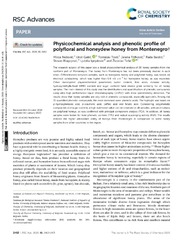Приказ основних података о документу
Physicochemical analysis and phenolic profile of polyfloral and honeydew honey from Montenegro
| dc.creator | Nešović, Milica | |
| dc.creator | Gašić, Uroš M. | |
| dc.creator | Tosti, Tomislav | |
| dc.creator | Trifković, Jelena | |
| dc.creator | Baošić, Rada | |
| dc.creator | Blagojević, Stevan | |
| dc.creator | Ignjatović, Ljubiša | |
| dc.creator | Tešić, Živoslav Lj. | |
| dc.date.accessioned | 2020-02-04T11:24:41Z | |
| dc.date.available | 2020-02-04T11:24:41Z | |
| dc.date.issued | 2020 | |
| dc.identifier.issn | 2046-2069 | |
| dc.identifier.uri | https://cherry.chem.bg.ac.rs/handle/123456789/3827 | |
| dc.description.abstract | The research subject of this paper was a detail physicochemical analysis of 28 honey samples from the northern part of Montenegro. The honey from Montenegro has not been previously studied in such detail. Differentiation between samples, such as honeydew honey and polyfloral honey, was based on electrical conductivity, which was higher than 0.8 mS cm-1 for honeydew honey, as was expected. Other investigated physicochemical parameters (water content, free acids, diastase activity, hydroxymethylfurfural (HMF) content and sugar content) have shown great similarity for all honey samples. The main interest of this study was the identification and quantification of phenolic compounds using ultra-high performance liquid chromatography (UHPLC) with mass spectrometry detection. The results show that honey samples are very rich in phenolic compounds, especially quercetin. Among the 31 quantified phenolic compounds, the most dominant were phenolic acids. The highlight was based on p-hydroxybenzoic acid, p-coumaric acid, caffeic acid and ferulic acid. Considering polyphenolic compounds and sugar content, a high nutritional value can be observed in all samples, with an emphasis on polyfloral honeys, as was confirmed with principal component analysis (PCA). In addition, all honey samples were tested for total phenolic content (TPC) and radical scavenging activity (RSA). The results indicate the higher antioxidant ability of honeys from Montenegro in comparison to some honey samples from other countries in the region. | |
| dc.publisher | Royal Society of Chemistry | |
| dc.relation | info:eu-repo/grantAgreement/MESTD/Basic Research (BR or ON)/172017/RS// | |
| dc.relation | info:eu-repo/grantAgreement/MESTD/Integrated and Interdisciplinary Research (IIR or III)/45014/RS// | |
| dc.rights | openAccess | |
| dc.rights.uri | https://creativecommons.org/licenses/by-nc/4.0/ | |
| dc.source | RSC Advances | |
| dc.title | Physicochemical analysis and phenolic profile of polyfloral and honeydew honey from Montenegro | |
| dc.type | article | |
| dc.rights.license | BY-NC | |
| dcterms.abstract | Гашић, Урош М.; Тости, Томислав; Тешић, Живослав Љ.; Игњатовић, Љубиша; Благојевић, Стеван; Баошић, Рада; Трифковић, Јелена; Нешовић, Милица; | |
| dc.citation.volume | 10 | |
| dc.citation.issue | 5 | |
| dc.citation.spage | 2462 | |
| dc.citation.epage | 2471 | |
| dc.identifier.wos | 000512409400004 | |
| dc.identifier.doi | 10.1039/c9ra08783d | |
| dc.citation.rank | M22 | |
| dc.description.other | Supplementary material: [http://cherry.chem.bg.ac.rs/handle/123456789/3828] | |
| dc.type.version | publishedVersion | |
| dc.identifier.scopus | 2-s2.0-85078301815 | |
| dc.identifier.fulltext | https://cherry.chem.bg.ac.rs/bitstream/id/16608/bitstream_16608.pdf |


